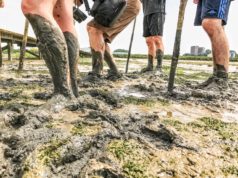From mid-May to July you may find oak trees all over the Netherlands wrapped in red-white warning tape. This is because of the oak processionary moth (OPM, or ‘eikenprocessierups’ in Dutch).
The poisonous bristles of these critters cause a lot of discomfort to both humans and animals; severe itching is the most well-known consequence.
The oak processionary is mainly spotted in oaks along streets in cities, towns and villages. The oak processionary is also observed in forest areas, but here there seems to be a biological balance with its natural enemies.
Infested oak trees can be recognized by silky nests around the branches and the trunk of the tree.
Oak processionary
Procession caterpillars move in long strings in succession, hence the name ‘oak processionary’.
From the third moulting stage (mid-May) the caterpillar develops characteristic bristles in addition to the normal white hairs. These arrow-shaped bristles are an active defense mechanism and are fired at a threat. The caterpillar does not need to be touched to come into contact with the bristles. They can also spread with the wind, as far as 500 meters.
Health risks
When contact with these stinging hairs occurs, health complaints may occur such as severe itching, bumps, skin rashes and redness of the skin as well as irritation of the airways and red and puffy eyes.
Sometimes the symptoms feel like a cold; a runny nose, coughing, difficulties to swallow, tickle in the throat and shortness of breath.
In addition to these common symptoms, other complaints such as vomiting, dizziness and fever may also occur.
The symptoms differ per person. Complaints can be more severe when you repeatedly come in contact with oak processionary caterpillars. Animals, especially dogs and horses, can also suffer from the symptoms.
Prevention is better than cure
Try to avoid any contact with oak processionary caterpillars.
Do’s
• teach children to keep a safe distance from infested oak trees
• keep pets, animals and livestock away from infested oak trees
• cover your neck, arms and legs
Don’ts
• don’t go near nests and caterpillars
• don’t try to remove nests yourself → report the nest to the local authorities
Did you get in contact with oak processionary caterpillars? Try to scratch or rub as little as possible. Rinse your skin and eyes with lukewarm water. Wash your clothes preferably at 60ºC to remove all bristles.
Strip your skin with sticky tape; stick it onto the skin and then pull it off again. This way you remove the poisonous caterpillar hairs. In case of severe itching, ointment or cream with menthol, aloe vera or calendula can give relief. You can find this at farmacies (‘apotheek’ in Dutch) and drug stores like Kruidvat, Etos and Holland & Barrett.
In general the symptoms disappear within a few days to two weeks.
When to get medical help?
Call a doctor immediately if you have difficulties breathing, get thick eyelids, thick lips or a thick tongue.
In case of eye problems you should seek medical help right away because a bristle in your eye can cause serious consequences. An inflammated eye can lead to blindness.



